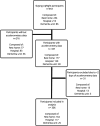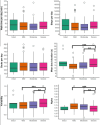Characterizing Walking Behaviors in Aged Residential Care Using Accelerometry, With Comparison Across Care Levels, Cognitive Status, and Physical Function: Cross-Sectional Study
- PMID: 38842168
- PMCID: PMC11185191
- DOI: 10.2196/53020
Characterizing Walking Behaviors in Aged Residential Care Using Accelerometry, With Comparison Across Care Levels, Cognitive Status, and Physical Function: Cross-Sectional Study
Abstract
Background: Walking is important for maintaining physical and mental well-being in aged residential care (ARC). Walking behaviors are not well characterized in ARC due to inconsistencies in assessment methods and metrics as well as limited research regarding the impact of care environment, cognition, or physical function on these behaviors. It is recommended that walking behaviors in ARC are assessed using validated digital methods that can capture low volumes of walking activity.
Objective: This study aims to characterize and compare accelerometry-derived walking behaviors in ARC residents across different care levels, cognitive abilities, and physical capacities.
Methods: A total of 306 ARC residents were recruited from the Staying UpRight randomized controlled trial from 3 care levels: rest home (n=164), hospital (n=117), and dementia care (n=25). Participants' cognitive status was classified as mild (n=87), moderate (n=128), or severe impairment (n=61); physical function was classified as high-moderate (n=74) and low-very low (n=222) using the Montreal Cognitive Assessment and the Short Physical Performance Battery cutoff scores, respectively. To assess walking, participants wore an accelerometer (Axivity AX3; dimensions: 23×32.5×7.6 mm; weight: 11 g; sampling rate: 100 Hz; range: ±8 g; and memory: 512 MB) on their lower back for 7 days. Outcomes included volume (ie, daily time spent walking, steps, and bouts), pattern (ie, mean walking bout duration and alpha), and variability (of bout length) of walking. Analysis of covariance was used to assess differences in walking behaviors between groups categorized by level of care, cognition, or physical function while controlling for age and sex. Tukey honest significant difference tests for multiple comparisons were used to determine where significant differences occurred. The effect sizes of group differences were calculated using Hedges g (0.2-0.4: small, 0.5-0.7: medium, and 0.8: large).
Results: Dementia care residents showed greater volumes of walking (P<.001; Hedges g=1.0-2.0), with longer (P<.001; Hedges g=0.7-0.8), more variable (P=.008 vs hospital; P<.001 vs rest home; Hedges g=0.6-0.9) bouts compared to other care levels with a lower alpha score (vs hospital: P<.001; Hedges g=0.9, vs rest home: P=.004; Hedges g=0.8). Residents with severe cognitive impairment took longer (P<.001; Hedges g=0.5-0.6), more variable (P<.001; Hedges g=0.4-0.6) bouts, compared to those with mild and moderate cognitive impairment. Residents with low-very low physical function had lower walking volumes (total walk time and bouts per day: P<.001; steps per day: P=.005; Hedges g=0.4-0.5) and higher variability (P=.04; Hedges g=0.2) compared to those with high-moderate capacity.
Conclusions: ARC residents across different levels of care, cognition, and physical function demonstrate different walking behaviors. However, ARC residents often present with varying levels of both cognitive and physical abilities, reflecting their complex multimorbid nature, which should be considered in further work. This work has demonstrated the importance of considering a nuanced framework of digital outcomes relating to volume, pattern, and variability of walking behaviors among ARC residents.
Keywords: accelerometry; aged residential care; cognitive dysfunction; mobility limitation; physical activity; residential aged care facility.
© Ríona Mc Ardle, Lynne Taylor, Alana Cavadino, Lynn Rochester, Silvia Del Din, Ngaire Kerse. Originally published in JMIR Aging (https://aging.jmir.org).
Conflict of interest statement
Figures
Similar articles
-
Comparison of patient-reported outcomes of physical activity and accelerometry in people with multiple sclerosis and ambulatory impairment: A cross-sectional study.Mult Scler Relat Disord. 2024 May;85:105532. doi: 10.1016/j.msard.2024.105532. Epub 2024 Mar 1. Mult Scler Relat Disord. 2024. PMID: 38452648
-
Mobility and cognition at admission to the nursing home - a cross-sectional study.BMC Geriatr. 2018 Jan 30;18(1):30. doi: 10.1186/s12877-018-0724-4. BMC Geriatr. 2018. PMID: 29378518 Free PMC article.
-
Folic acid supplementation and malaria susceptibility and severity among people taking antifolate antimalarial drugs in endemic areas.Cochrane Database Syst Rev. 2022 Feb 1;2(2022):CD014217. doi: 10.1002/14651858.CD014217. Cochrane Database Syst Rev. 2022. PMID: 36321557 Free PMC article.
-
Free-living monitoring of ambulatory activity after treatments for lower extremity musculoskeletal cancers using an accelerometer-based wearable - a new paradigm to outcome assessment in musculoskeletal oncology?Disabil Rehabil. 2023 Jun;45(12):2021-2030. doi: 10.1080/09638288.2022.2083701. Epub 2022 Jun 16. Disabil Rehabil. 2023. PMID: 35710327
-
Screening for Cognitive Impairment in Older Adults: An Evidence Update for the U.S. Preventive Services Task Force [Internet].Rockville (MD): Agency for Healthcare Research and Quality (US); 2020 Feb. Report No.: 19-05257-EF-1. Rockville (MD): Agency for Healthcare Research and Quality (US); 2020 Feb. Report No.: 19-05257-EF-1. PMID: 32129963 Free Books & Documents. Review.
Cited by
-
A Full-Body IMU-Based Motion Dataset of Daily Tasks by Older and Younger Adults.Sci Data. 2025 Mar 29;12(1):531. doi: 10.1038/s41597-025-04818-y. Sci Data. 2025. PMID: 40157915 Free PMC article.
-
Video Games and Gamification for Assessing Mild Cognitive Impairment: Scoping Review.JMIR Ment Health. 2025 Aug 5;12:e71304. doi: 10.2196/71304. JMIR Ment Health. 2025. PMID: 40762973 Free PMC article. Review.
-
Sarcopenia and Risk of Cognitive Impairment: Cohort Study and Mendelian Randomization Analysis.JMIR Aging. 2025 Jun 11;8:e66031. doi: 10.2196/66031. JMIR Aging. 2025. PMID: 40499039 Free PMC article.
References
-
- Fritz S, Lusardi M. White paper: "walking speed: the sixth vital sign". J Geriatr Phys Ther. 2009;32(2):46–49. Medline. - PubMed
-
- Sherrington C, Fairhall N, Kwok W, et al. Evidence on physical activity and falls prevention for people aged 65+ years: systematic review to inform the WHO guidelines on physical activity and sedentary behaviour. Int J Behav Nutr Phys Act. 2020 Nov 26;17(1):144. doi: 10.1186/s12966-020-01041-3. doi. Medline. - DOI - PMC - PubMed
Publication types
MeSH terms
Grants and funding
LinkOut - more resources
Full Text Sources
Miscellaneous




